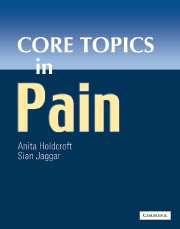Book contents
- Frontmatter
- Contents
- Contributors
- Preface
- Acknowledgements
- Foreword
- General abbreviations
- Basic science abbreviations
- PART 1 BASIC SCIENCE
- PART 2 PAIN ASSESSMENT
- Section 2a Pain measurement
- Section 2b Diagnostic strategies
- PART 3 PAIN IN THE CLINICAL SETTING
- Section 3a Clinical presentations
- Section 3b Pain syndromes
- PART 4 THE ROLE OF EVIDENCE IN PAIN MANAGEMENT
- PART 5 TREATMENT OF PAIN
- Section 5a General Principles
- Section 5b Physical treatments
- Section 5c Pharmacology
- Section 5d Psychosocial
- 44 Psychological management of chronic pain
- 45 Psychiatric disorders and pain
- 46 Chronic pain and addiction
- 47 The role of the family in children's pain
- 48 Palliative care
- PART 6 SUMMARIES
- Glossary
- Index
45 - Psychiatric disorders and pain
from Section 5d - Psychosocial
Published online by Cambridge University Press: 10 December 2009
- Frontmatter
- Contents
- Contributors
- Preface
- Acknowledgements
- Foreword
- General abbreviations
- Basic science abbreviations
- PART 1 BASIC SCIENCE
- PART 2 PAIN ASSESSMENT
- Section 2a Pain measurement
- Section 2b Diagnostic strategies
- PART 3 PAIN IN THE CLINICAL SETTING
- Section 3a Clinical presentations
- Section 3b Pain syndromes
- PART 4 THE ROLE OF EVIDENCE IN PAIN MANAGEMENT
- PART 5 TREATMENT OF PAIN
- Section 5a General Principles
- Section 5b Physical treatments
- Section 5c Pharmacology
- Section 5d Psychosocial
- 44 Psychological management of chronic pain
- 45 Psychiatric disorders and pain
- 46 Chronic pain and addiction
- 47 The role of the family in children's pain
- 48 Palliative care
- PART 6 SUMMARIES
- Glossary
- Index
Summary
Patients with chronic pain frequently have emotional difficulties that often amount to frank psychiatric illness. There is an increased prevalence of depression, anxiety, somatoform disorders, personality disorders and substance abuse compared with the general population. In one of the UK surveys almost a third of patients seen in a pain clinic service had symptoms sufficient to warrant a definite psychiatric diagnosis (Tyrer et al., 1989). Of the patients who were psychiatrically ill, two-thirds had a depressive illness. Between 25% and 30% of women attending a gynaecological clinic have evidence of depression, and persistent chest pain in young adults (particularly exertional pain) is strongly associated with psychiatric illness. Pain and emotional illness are clearly closely related.
Classificatory schedules for psychiatric disorders in pain
There are two widely used schedules for the classification of psychiatric disorders:
The International Classification of Diseases-Tenth Edition (ICD-10).
The Diagnostic and Statistical Manual for Mental Disorders-Fourth Edition (DSM-IV).
The International Association for the Study of Pain (IASP) has developed its own classification for painful conditions.
As the ICD-10 is the instrument most frequently employed in Europe, the psychiatric disorders will be listed according to this system. A comparison of the diagnoses used in all three systems is shown in Table 45.1.
- Type
- Chapter
- Information
- Core Topics in Pain , pp. 299 - 304Publisher: Cambridge University PressPrint publication year: 2005
- 1
- Cited by



